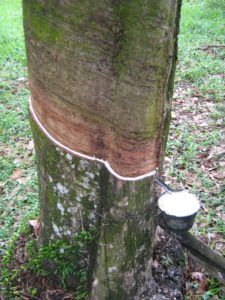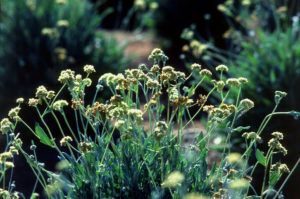Enough Rubber to Meet the Road? Managing the Natural Rubber Supply Chain

Climate change may contribute to a shortage of natural rubber as global tire demand continues to grow. Will Cooper Tire be able to source a viable rubber alternative?
Today, the vast majority of the world’s natural rubber comes from the para-rubber tree (Hevea brasiliensi), a species of tree grown in a fairly limited geographic region in Southeast Asia [1]. In 2016, the world produced over 27 billion pounds of Hevea natural rubber, over 70% of which was used by the tire industry [2]. In coming years, global consumption of natural rubber is expected to continue to grow, and as less developed nations industrialize, global demand for tires could require as much as 21 million additional acres of Hevea by 2024 [3].
Cooper Tire & Rubber Company

A leading tire manufacturer, Cooper Tire & Rubber Company (“Cooper”) relies heavily on raw material inputs, especially natural rubber [4]. As global natural rubber consumption continues to increase, Cooper may be hard pressed to procure an adequate supply of natural rubber, especially as climate change threatens para-rubber tree production. Notably:
- Extreme weather, such as drought and heavy rains, may reduce the number of available rubber tree tapping days [5]
- As global temperatures increase, latex flow from para-rubber trees — and therefore rubber yield — may fall [6]
- Increased precipitation for high altitude plantations in tropical growing regions accelerates the risk of erosion [7]
Taken alongside the projected global demand growth for natural rubber, these potential threats to the para-rubber tree supply chain are driving companies such as Cooper to push to find new sources of natural rubber [8].
Cooper’s Response

In response to these pressures, Cooper has turned its attention to a new potential source of natural rubber: a flowering desert shrub known as Parthenium argentatum, or guayule, that is grown in the Southwestern U.S. [9]
In 2017, Cooper — along with consortium partners Clemson University, Cornell University, PanAridus and the Agricultural Research Service of the USDA-ARS — completed a five-year USDA grant to study the use of guayule in tire applications, building over 450 tires and replacing Hevea and synthetic rubber components with parts made of guayule [10]. Ultimately, Cooper discovered that it was able to successfully produce and test concept tires that were comparable to those made with Hevea; what’s more, the guayule rubber tires performed better in tests of rolling resistance, wet handling and wet braking [11].
These findings are just the beginning. With proof of concept in hand, Cooper must take several actions to scale guayule tire production in the next decade:
- Refine manufacturing techniques: while Cooper was able to successfully produce concept guayale tires, the company should continue to investigate ways to reduce costs and scale manufacturing techniques. The USDA study, for example, demonstrated large productivity improvements when subsurface drip irrigation was used vs. surface irrigation [12].
- Encourage capital investment to support guayale development: it is likely that the combined effort of the government and agriculture industry will be needed to grow guayule plants and build large-scale manufacturing operations to supply the tire manufacturing industry [13].
- Continue searching for alternate sources of natural rubber: Interest in alternative rubber sources has risen and fallen throughout history. During World War II, for example, the “Emergency Rubber Project” emerged when Japan cut off access to Hevea-based rubber, leading countries to study various rubber alternatives including guayale and a dandelion called Taraxacum kok-saghyz [14]. Though interest in these efforts fell off when the war ended, such alternatives may prove to be viable natural rubber substitutes.
Given the time required to scale guayule production, in the short term Cooper will continue to focus on its current Hevea natural rubber supply chain in Southeast Asia. Cooper’s Singapore-based purchasing office allows the company to work directly with producers to continually improve consistency and quality while reducing material costs [15]. Additionally, Cooper should continue to focus on long-term supplier agreements and purchase agreements to mitigate the risks of natural rubber pricing volatility [16].
The road ahead
With promising results from the five-year study in hand, the question remains whether it will be possible to achieve guayule rubber commercialization given the complexity of implementation. Specifically,
- Will Cooper be able to develop agricultural and processing infrastructure in order to process guayule on an industrial scale? [17]
- If so, will Cooper realize sufficient economic scale and efficiencies to make guayule pricing competitive to that of Hevea in the tire industry? [18]
- Will existing tire manufacturing plants be willing to adjust operations in order to accommodate guayule natural rubber processing in addition to or in place of Hevea natural rubber processing? [19]
(733 words)
—
[1] Jesse Emspak, “Alternative Source of Tire Rubber Gains Traction”, Scientific American, October 6, 2014, https://www.scientificamerican.com/article/alternative-source-of-tire-rubber-gains-traction, accessed November 2017.
[2] Cooper Tire & Rubber Company, “News”, http://coopertire.com/News/Guayule.aspx, accessed November 2017.
[3] Diane Cardwell, “Making Tires From a Desert Shrub Found in the U.S.”, The New York Times, August 18. 2015, https://www.nytimes.com/2015/08/19/business/making-tires-from-a-desert-shrub-found-in-the-us.html, accessed November 2017.
[4] Cooper Tire & Rubber Company. December 31, 2016 Form 10-K. http://investors.coopertire.com/Cache/38117873.pdf, accessed November 2017.
[5] Roberta Kwok, “Risky Rubber Plantations: A Lose-Lose Scenario”, Conservation Magazine, July 9, 2015, http://www.conservationmagazine.org/2015/07/risky-rubber-plantations-a-lose-lose-scenario/, accessed November 2017.
[6] “Tea and rubber equally affected by global warming, climate change”, Daily Mirror, March 20, 2014, http://www.dailymirror.lk/44738/tea-and-rubber-equally-affected-by-global-warming-climate-change, accessed November 2017.
[7] Antje Ahrend, Peter M. Hollingsworth, Alan D. Ziegler, Jefferson M. Fox, Huafang Chen, Yufang Su, Jianchu Xu, “Current trends of rubber plantation expansion may threaten biodiversity and livelihoods”, Global Environmental Change 34 (2015): 48-58, https://ac.els-cdn.com/S0959378015000801/1-s2.0-S0959378015000801-main.pdf?_tid=d11c63aa-c9bf-11e7-8fce-00000aacb35f&acdnat=1510721314_b90ae6e472a18f387b903456b6c0fefa, accessed November 2017.
[8] Diane Cardwell, “Making Tires From a Desert Shrub Found in the U.S.”, The New York Times, August 18. 2015, https://www.nytimes.com/2015/08/19/business/making-tires-from-a-desert-shrub-found-in-the-us.html, accessed November 2017.
[9] Ibid.
[10] Cooper Tire & Rubber Company, “News”, http://coopertire.com/News/Guayule.aspx, accessed November 2017.
[11] Ibid.
[12] Cooper Tire & Rubber Company, “Cooper Tire and Consortium Partners Complete $6.9 Million USDA Grant to Study Guayule Polymer for Tire Applications”, press release, August 10, 2017. http://coopertire.com/News/Corporate-News-Releases/Cooper-Tire-and-Consortium-Partners-Complete-$6-9.aspx, accessed November 2017.
[13] Ibid.
[14] Jesse Emspak, “Alternative Source of Tire Rubber Gains Traction”, Scientific American, October 6, 2014, https://www.scientificamerican.com/article/alternative-source-of-tire-rubber-gains-traction, accessed November 2017.
[15] Cooper Tire & Rubber Company. December 31, 2016 Form 10-K. http://investors.coopertire.com/Cache/38117873.pdf, accessed November 2017.
[16] Ibid.
[17] Cooper Tire & Rubber Company, “News”, http://coopertire.com/News/Guayule.aspx, accessed November 2017.
[18] Ibid.
[19] Ibid.



I really enjoyed this article and had no idea that rubber came from trees…which leads me to my question while reading this article: Is rubber currently being recycled, and if so, at what rate and does it have the same quality?
I couldn’t help but draw connections to the recent IKEA case. For tire manufacturers, based on your research, it is apparent that there could be a shortage of raw materials in the future, similar to the problem that IKEA is facing with tree harvesting. I’m curious if there are laws and regulations in place to protect the para-rubber tree and the guayule to prevent over-harvesting.
The first question you bring up is quite interesting, and I think it applies to many companies that are heavily affected by climate change. How much should a company invest in sustainability initiatives, when these initiatives often require a heavy up-front investment? In this case, it seems that Cooper should strongly looking into these initiatives since they heavily use raw materials for their products, much like IKEA.
Very interesting article. The guayule tree seems to be an interesting alternative to cover the shortfall of para-rubber supply. While it might be a great temporary solution, I wonder if some of the same risks that apply to the para-rubber tree could ultimately impact the guayule tree (such as impact from drought, heavy rains, temperature, etc.). I’m also curious how the effects on the environment of growing guayule trees might be better or worse than the effects of growing para-rubber trees. It seems like guayule trees need less water, which would definitely be more beneficial[1].
Perhaps another solution would be to invest in R&D to produce synthetic rubber tires. Some of the existing methods of making synthetic rubber are not very green, but there is talk of new low-carbon methods[2]. While developing a new way to make tires that does not depend on growing plants might be a heavy initial investment, it could pay off quickly if it makes the process much more efficient. Not to mention, it could have even less of an impact on the environment.
[1] Patrick Cain, “How Tire Company Bridgestone Is Solving A Tricky Natural-Resource Issue,” Fast Company, July 24, 2014, https://www.fastcompany.com/3033390/how-tire-company-firestone-is-solving-a-tricky-natural-resource-issue, accessed November 2017.
[2] Adam Fisher, “Cleaner, Greener Synthetic Rubber Tires Start to Roll,” Money Watch, March 24, 2010, https://www.cbsnews.com/news/cleaner-greener-synthetic-rubber-tires-start-to-roll/, accessed November 2017.
Really interesting. Thanks for the article! Similar to the previous comments, I was wondering about whether the impact of climate change will ultimately harm the guayule trees, hindering production from this new source, and put Cooper back into this same situation.
Given that, could they pursue a concurrent R&D effort to identify a different type of tire overall? For example, a tire that requires less rubber (or synthetic) material in the first place? For example, reading about some of the innovations in the tire space, there was a concept tried by Michelin in 2005 called the “Tweel”– an airless tire that uses less rubber since only the tread around the spokes need to be replaced
https://www.digitaltrends.com/cars/modern-tire-technology-basics/
This is an interesting approach that Cooper Tire has taken to completely change the primary source of its products. Maybe they have already tried but my first instinct as Cooper would have been to try and see if the existing rubber trees can be grown in a different geographic location and slightly different climatic conditions. This research and experiment would probably be more stable than actually replacing the entire key raw material in your product that has sustained your company for long.
From my understanding of high-performance rubber, it is extremely critical for the rubber to be natural. With these new experiments, these tests may take longer as rubber testing really needs to last the test of time – as good rubber needs to last a long time and should remain cool even with loads as high as an aircraft.